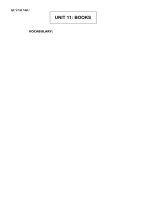Vocabulary of analytical chemistry
Bạn đang xem bản rút gọn của tài liệu. Xem và tải ngay bản đầy đủ của tài liệu tại đây (138.19 KB, 14 trang )
Lecture 2
Vocabulary of analytical chemistry
Contents
Measurements, analysis, determination
4 levels of methodology
Criteria to select an analytical method
Develop a procedure
Measurements, determinations and analysis
Analyse
(Phân tích)
Determine
(Xác định)
Measure
(Đo)
Analyse drinking water in Hanoi:
Determine identities,
properties, concentrations of
toxic chemicals such as As
Measure absorbance of
AsH3 by HVG-AAS
technique
4 levels of analytical methodology
Technique (kĩ thuật) : any chemical or physical principle to
study an analyte
Exp: AAS; F-AAS; ICP-MS .. techniques.
Method (phương pháp): application of a technique for a
specific analyte in a specific matrix.
Exp: F-AAS method to determine Pb in drinking water;
F-AAS method to determine Pb in ores.
Procedure (qui trình): a set of written directions telling us how
to apply a method to a particular sample, including
information on obtaining samples, handling interferents, and
validating results.
A method may have several procedures.
Protocol (thủ tục) : a set of stringent guidelines specifying a
procedure that must be followed if an agency is to accept the
results.
APHA: American Public Health Association
ASTM: American Society for Testing Materials
EPA: Environmental Protection Agency
Criteria to select an analytical method
Accuracy (độ chính xác) : agreement between experimental data
and the “true” or expected result
Absolute error:
E = xi - xt (where xt = true or accepted value)
x −x
Relative error:
t × 100%
E = i
r
x
t
Precision (độ chụm): the agreement between replicate
experimental analyses.
d i = xi − x
individual value
Mean value
Or standard deviation (Sd)= Σd2/n
*Độ chính xác(accuracy) = độ đúng (trueness) + độ chụm
(precission)
Example 1:
Glucose concentration in blood: 6 mg/L.
You determine concentration: 5 mg/L
What’s the error =?
Example 2:
You measure 5 times: 5.0; 5.2; 4.7; 5.1; 4.9 (mg/L)
Your colleague measures 5 times: 4.0; 6.7; 6.8; 6.3; 5.4
(mg/L)
Who’s precision better?
Who’s accuracy better?
Illustrating the difference between “accuracy” and “precision”
Low accuracy, low precision
Low accuracy, high precision
High accuracy, low precision
High accuracy, high precision
Sensitivity (độ nhạy): Ability to detect the change of signal when
there is a change in the amount of analyte. (equivalent to ka in S a =
kana or Sa = kaCa)
Sensitive to change in temperature, hot or cold, skin, hair,
thermometer, ...
skin: 0.1°, thermometer: 0.1° – 0.001°)
Detection limit (gioi han phat hien): smallest amount of analyte that
can be determined with confidence.
Titration: LOD: 10-4M
ICP-MS: LOD: 10-9M
Criteria to select an analytical method
Specificity (độ đặc thù): if the signal depends only on the
analyte.
Selectivity (độ chọn lọc): a measure of a method’s freedom from
interferences.
Selectivity coefficient: ka,I= kI/ka
- K can be positive (interferent increases signal),
negative (interferent decreases signal),
magnitude can be > 1 or < 1;
the smaller K, the more selectivity the method.
Criteria to select a method
Robustness (tính ổn định): ability to use an analytical method
on many analytes in a wide variety of sample matrices.
Ruggedness (tính không ổn định): in contrast with robustness,
ability to provide accurate results despite variations in
executing a method (variation in pH, T, …).
Scale of operation: the amount of sample available for the
analysis, the expected concentration of analyte in the samples,
and the minimum amount of analyte that produces a
measurable signal
Develop a procedure
Method blank (thí nghiệm trắng): compensate for
interferences, measure the signal of solution that does
not contain the sample
Calibration curve (đường chuẩn): determine ka using one
or more standards.
Develop a procedure
Sampling (lấy mẫu) : collecting and preparing
samples
(more in Chapter 7)
Validation (xác nhận giá trị sử dụng của phương
pháp): uses a standard sample, whose composition
closely matches the samples that will be analyzed or
compared, with a method with known accuracy
(more in Chapter 14).









